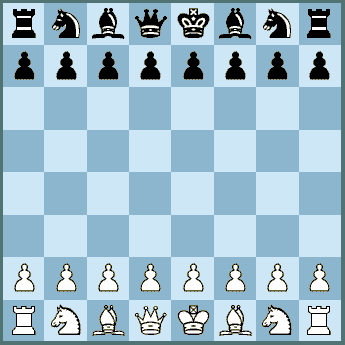

Normal chess rules apply except for the following. (By the term ‘figure’ I mean all figures, including pawns.) Any pawn situated on the same file as a friendly figure, with zero or more empty squares in between, can leap forwards over the latter and land on an enemy figure standing on the same file, provided that there is just one friendly figure in between. The pawn can land on all enemy figures on the file, but not on empty squares. However, enemy figures positioned behind an enemy pawn (or yet another friendly figure) cannot be reached, although the enemy pawn, in itself, can be captured. When the pawn lands it behaves like a cannon shell and "explodes", that is, it is removed together with the enemy figure.
This piece movement functions similarly as a cannon. It opens up interesting tactical and strategical possibilities during all phases of the game. One such possibilty is to exchange a pawn on the same file in order to open the file for continued attack. Pawns that fulfil the requirements for making a jump are referred to as "cannons".
Weakening the e-file in the opening by moving the pawn two steps could be dangerous, while it compromises the King’s position. Despite the obvious tactical dangers, the positional qualities of the game are retained. But the risk of draw is probably lessened since opening of files for attack is facilitated.
One could argue that the value of the pawn is higher in Gunnery Chess than in regular chess. However, the cannon capability belongs equally much to the other pieces, because it is a cooperative move. In the images below, which piece generates the cannon move? Is it the knight or the pawn behind it? As the cannon move increases the power of all figures, I believe that the relative value of the figures is retained.
The cannon move is less brutal than one would expect. This is because the leaping pawn also annihilates itself. In practical endgames one could put the king in front of a pawn, and let the pawn leap over the board to capture an enemy pawn. But the result is only that both pawns are removed. Such maneuvers cost time, and the gain could be nil. This fact, and the fact that pawns can protect friendly figures from cannon attacks, assures that the positional soundness of the game is retained. The introduction of the cannon move does not degrade the game to a tactical turmoil, but it clearly enhances the tactical nature of the game.
There is also a variant that features Scorpion pawns (see Scorpion Chess). The Scorpion has the additional moves of a knight, but only in two forward directions: east-north-east, and west-north-west. There are no additional capture moves. The Scorpion’s value is half the value of a knight or bishop, that is, 1.5. This means that a light piece can be exchanged for two Scorpions, a possibility which often occurs. In the endgame it could become very dangerous, and its value often increases.
According to the dictionary the term gunnery refers to the use of guns; esp: the science of the flight of projectiles and of the effective use of guns. Gunnery Chess was invented by undersigned, June 2006.
Examples

In this position white’s pawn can reach the black knight and the black pawn, but not the bishop (and not the empty square before the black knight).
 Here white’s pawn can reach and "explode" any of the three black pieces.
Here white’s pawn can reach and "explode" any of the three black pieces.
 Here white’s pawn cannot reach any of the black pieces.
Here white’s pawn cannot reach any of the black pieces.
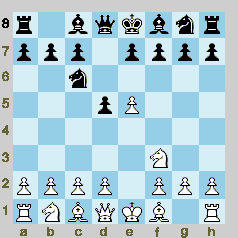 This is an example of opening calamity. After the moves 1.e4 Nc6 2.Nf3 d5 white made the error of playing 3.e5 ... (diagram position). Black punishes this by 3...Nxe5 4.Nxe5 Be6 checkmate! White cannot go between with a piece because the cannon on e7 reaches the king on e1 in any case. This is a "fools mate" in Gunnery Chess.
This is an example of opening calamity. After the moves 1.e4 Nc6 2.Nf3 d5 white made the error of playing 3.e5 ... (diagram position). Black punishes this by 3...Nxe5 4.Nxe5 Be6 checkmate! White cannot go between with a piece because the cannon on e7 reaches the king on e1 in any case. This is a "fools mate" in Gunnery Chess.
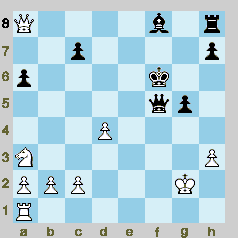 Black finesses himself out of his problems in this position: 1...Qxh3+! 2.Kxh3 Bh6+ This is a cannon check from the cannon on h7! 3.Kg4 Rxa8 and black has equalized.
Black finesses himself out of his problems in this position: 1...Qxh3+! 2.Kxh3 Bh6+ This is a cannon check from the cannon on h7! 3.Kg4 Rxa8 and black has equalized.
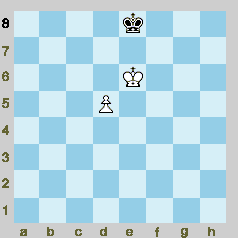 With White to move this is a draw in regular chess. But here, if White plays 1.Ke6-d6 and places his king in front of the pawn, black cannot oppose because the promotion square is controlled by the cannon pawn. Hence White wins. Theoretical endgames are more promising to the stronger party in Gunnery Chess.
With White to move this is a draw in regular chess. But here, if White plays 1.Ke6-d6 and places his king in front of the pawn, black cannot oppose because the promotion square is controlled by the cannon pawn. Hence White wins. Theoretical endgames are more promising to the stronger party in Gunnery Chess.
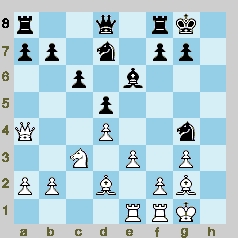 This position looks harmless, but black simply plays 1...Qh4 followed by mate on h2. White’s pawn on g3 is pinned by the cannon on g7.
This position looks harmless, but black simply plays 1...Qh4 followed by mate on h2. White’s pawn on g3 is pinned by the cannon on g7.
• You can download my free Gunnery Chess program here, (updated 2006-07-07) but you must own the software Zillions of Games to be able to run it.
• Try playing Gunnery Chess per e-mail, against a human opponent, here.
• ...or try the variant with Scorpion pawns here.
• Don’t miss my other chess variants.
© M. Winther 2006